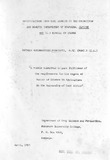| dc.contributor.author | Rubaihayo, Patrick Rutimbanzigu | |
| dc.date.accessioned | 2016-06-14T08:34:16Z | |
| dc.date.available | 2016-06-14T08:34:16Z | |
| dc.date.issued | 1969 | |
| dc.identifier.uri | http://hdl.handle.net/11295/96109 | |
| dc.description.abstract | The present investigations have revealed tlat Soyabeans were of considerable agricultural importance in the 1940’s but the present acreage sown to Soyabean is quite insignificant.
The crop can be satisfactorily grown ii many parts of Uganda. With the present government’s diversification policy and adapted high yielding cultivars and a good knowledge of agronomic aspects of cultivation, Soyabean production can be expected to increase again and be able to contribute to the agricultural economy of the country.
The experimental work described in the thesis was aimed at the evaluation of as many as possible of the available soyabean cultivars at Kabanyolo University Farm in order to screen out some potential commercial cultivars for the country and also to investigate problems of Soyabean cultivation.
A large number of cultivars has been collected at Kabanyolo for trial. They were grouped into three groups based on the period from sowing to maturity. The quick maturity types yielded poorly and the very longest termed cultivars did not crop well while the medium to the long term types yielded best. Some cultivars have yielded over 3000 lbs. per acre on experimental plot basis and have been recommended for commercial
production.
The optimum time of planting has been investigated and, as with many other crops, yields can fall rapidly if planting is delayed once the rains have properly broken. The results have shown that Soyabeans should be planted with the first consistent rains, but if they come and then stop for more than three weeks, then the time regarded as early planting is when they start again. The problem of it being very difficult in practice to decide when it is safe to assume that the rains have really begun is considerable in bast African agriculture, ihis is usually clear retrospectively but that is too late. Reduction in yields of over 40% have been recorded with 5 weeks of delayed planting after the rains have started.
The spacing has also been investigated and narrow interrow
and intra-row spacing arrangement has been found to give the highest yields. Yields were increased by over 40% by changing from the traditional spacing of 24” x 4” to 12f' x 2". The major limitation for closer inter-row spacing is weed control and this remains a practical difficulty in the cultivation
of the crop . Further research needs to be done with herbicides from the start that has been made and is reported in the thesis.
Soyabeans appear to show fairly inconsistent response to single fertiliser application but have showed constant and significant positive response to mixed fertilisers.
The interactions between cultivars (genotypes) and environments (seasons and locations) have been investigated. The genotype x season interactions were not significant at 5-6 level of probability but the genotype x location interactions
were significant at the same level. This stressed the importance of using centres all over the country for testing and selecting cultivars to be recommended for commercial production. | en_US |
| dc.language.iso | en | en_US |
| dc.publisher | University of Nairobi | en_US |
| dc.rights | Attribution-NonCommercial-NoDerivs 3.0 United States | * |
| dc.rights.uri | http://creativecommons.org/licenses/by-nc-nd/3.0/us/ | * |
| dc.title | Investigations into some aspects of the production and genetics improvement of Soyabean, Glycine Max (L) Merrill in Uganda | en_US |
| dc.type | Thesis | en_US |



